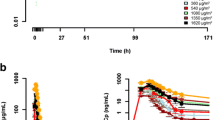Summary
Background ES-285 (spisulosine) is a novel compound derived from the marine mollusk Spisula polynoma with evidence of preclinical antitumor activity. This phase I clinical trial was designed to identify the maximum tolerated dose (MTD) and the recommended dose for phase II trials (RD), as well as to evaluate the safety profile, pharmacokinetics and preliminary efficacy data of ES-285 in patients with advanced solid tumors. Patients and Methods Sixty-one patients at two medical institutions were treated with a 3-h ES-285 intravenous infusion every 3 weeks. Nine dose levels were evaluated. Results No dose-limiting toxicities (DLTs) were observed during dose escalation from 4 to 128 mg/m2. Six patients had seven DLTs at the three highest dose levels tested: 256 mg/m2 (n = 2), 200 mg/m2 (n = 3) and 160 mg/m2 (n = 1). Grade 3/4 transaminase increases (n = 3), grade 3/4 central nervous system disorders [confusion (n = 2) and ataxia (n = 1)], and grade 3 pyrexia (n = 1) were the dose-limiting toxicities found with this ES-285 administration schedule. Pharmacokinetic analysis showed ES-285 dose linearity, wide distribution and a long half-life. One non-confirmed partial response was observed in a patient with metastatic melanoma treated with ES-285 128 mg/m2, and 18 patients showed stable disease at different dose levels, lasting longer than 3 months in six patients. Conclusion Dose level VIII (200 mg/m2) was considered the MTD, and dose level IX (160 mg/m2) was defined as the RD. Limited antitumor activity was observed.


Similar content being viewed by others
References
Faircloth G, Cuevas C, Kahalalide F, ES285 (2006) Potent anticancer agents from marine molluscs. Prog Mol Subcell Biol 43:363–379
Den Brok MW, Nuijen B, Meijer DM et al (2005) Pharmaceutical development of a parenteral lyophilised formulation of the investigational anticancer agent ES-285.HCl. PDA J Pharm Sci Technol 59:246–257
Den Brok MW, Nuijen B, Garcia JL et al (2006) Compatibility and stability of the novel anticancer agent ES-285 x HCl formulated with 2-hydroxypropyl-beta-cyclodextrin in infusion devices. Pharmazie 61:21–24
Cuadros R, Montejo E, Wendosell F, et al. (2000) The effects of spisulosine (ES-285), a marine natural product, on the morphology and survival of tumor cells. 11th NCI-EORTC-AACR Symposium on New Drugs in Cancer Therapy, Amsterdam, November 7–10
Cuadros R, Montejo de Garcini E, Wandosell F et al (2000) The marine compound spisulosine, an inhibitor of cell proliferation, promotes the disassembly of actin stress fibers. Cancer Lett 152:23–29
Baird R, Clarke P, Workman P (2005) ES-285, a novel marine anticancer agent: investigation of mechanism of action using gene expression microarrays. AACR Meeting Abstracts: 970
Alvarez-Miranda M, Rodriguez-Gonzalez A, Ramirez de Molina A, et al. (2007) ES-285 an anticancer agent of marine origin that acts through the ceramide pathway. AACR Meeting Abstracts: 1444
Sanchez AM, Malagarie-Cazenave S, Olea N et al (2008) Spisulosine (ES-285) induces prostate tumor PC-3 and LNCaP cell death by de novo synthesis of ceramide and PKCzeta activation. Eur J Pharmacol 584:237–245
Salcedo M, Cuevas C, Alonso JL et al (2007) The marine sphingolipid-derived compound ES 285 triggers an atypical cell death pathway. Apoptosis 12:395–409
Baird DB, Kitzen J, Clarke PA et al (2009) Phase I safety, pharmacokinetic and pharmacogenomic trial of ES-285, a novel marine cytotoxic agent, administered to adult patients with advanced solid tumors. Mol Cancer Ther 8(6):1430–1437
Vilar E, Grünwald V, Schöffski P, et al. (2010) A phase I dose-escalating study of ES-285, a marine sphingolypidderived compound, with repeat-dose administration in patients with advanced solid tumors. Invest New Drugs vol. in press: 1–7
Schöffski P, Dumez H, Ruijter R, et al. (2011) Spisulosine (ES-285) given as a weekly three-hour intravenous infusion: results of a phase I dose-escalating study in patients with advance solid malignancies. Cancer Chemother Pharmacol vol. in press: 1–7
Massard C, Majem M, Soria JC, et al. (2007) A phase I (3 h infusion every 3 weeks) escalating dose study of intravenous ES-285 in patients with advanced malignant solid tumors. AACR Meeting Abstracts (Molecular Targets Meeting)
Therasse P, Arbuck SG, Eisenhauer EA, Wanders J, Kaplan RS, Rubinstein L, Verweij J, Van Glabbeke M, van Oosterom AT, Christian MC, Gwyther SG (2000) New guidelines to evaluate the response to treatment in solid tumors. European Organization for Research and Treatment of Cancer, National Cancer Institute of the United States, National Cancer Institute of Canada. J Natl Cancer Inst 92(3):205–216
Stokvis E, Nan-Offeringa L, Rosing H et al (2003) Quantitative analysis of ES-285, an investigational marine anticancer drug, in human, mouse, rat, and dog plasma using coupled liquid chromatography and tandem mass spectrometry. J Mass Spectrom 38(5):548–554
Stokvis E, Rosing H, López-Lazaro L et al (2004) A more sensitive MS detector does not obviously lead to a more sensitive assay: experiences with ES-285. Biomed Chromatogr 18:403–407
Acknowledgements
We thank all of the staff who contributed to the care of the patients included in this study.
Conflict of interest statement
A. Soto and E. Fernández-García are employees of Pharma Mar. No other potential conflicts of interest were disclosed.
Author information
Authors and Affiliations
Corresponding author
Additional information
Phase I study of marine compound ES-285
Rights and permissions
About this article
Cite this article
Massard, C., Salazar, R., Armand, J.P. et al. Phase I dose-escalating study of ES-285 given as a three-hour intravenous infusion every three weeks in patients with advanced malignant solid tumors. Invest New Drugs 30, 2318–2326 (2012). https://doi.org/10.1007/s10637-011-9772-8
Received:
Accepted:
Published:
Issue Date:
DOI: https://doi.org/10.1007/s10637-011-9772-8




